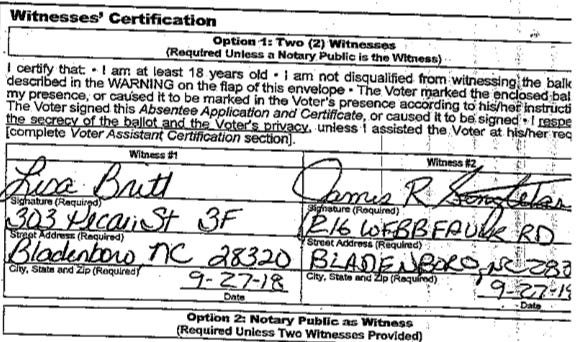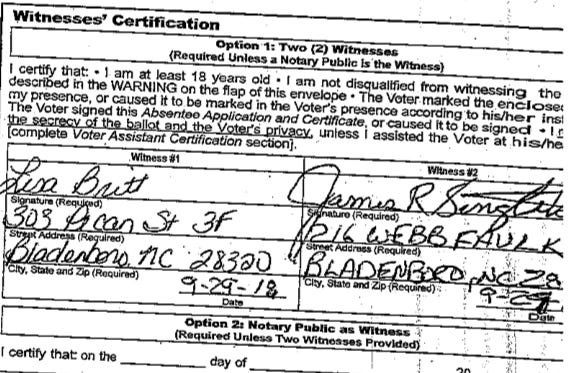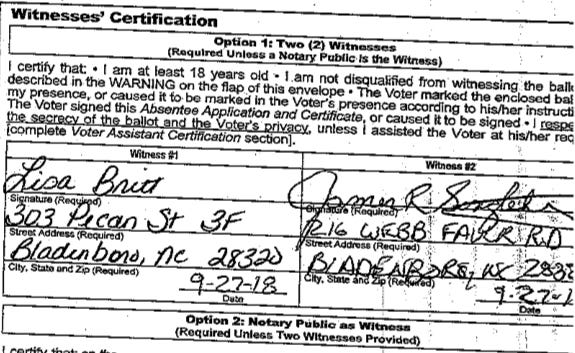EXCLUSIVE: Absentee ballot envelopes in North Carolina fit into "a pattern of fraud"
The Congressional race in North Carolina's 9th district, where Republican Mark Harris is leading Democrat Dan McCready by just 905 votes, has drawn national attention because of highly unusual patterns in mail-in absentee ballots.
In Bladen County, for example, only 19% of mail-in absentee ballots were requested by Republicans, but Harris won 61% of the mail-in absentee ballot vote. In every other county, including Republican strongholds like Union County, McCready won the mail-in absentee vote.
So what happened?
The envelopes of the absentee ballots are a rich source of information because they require not only the signature of the voter but the signature of two witnesses. Pending an investigation by the North Carolina State Board of Elections, which voted unanimously against certifying the election, these envelopes have been impounded.
Under normal circumstances, however, these envelopes are available at the local election board for review as public information. Before the Board of Election's action, 162 of the absentee ballot envelopes were photocopied. Popular Information obtained the images of these envelopes through a source.
Gerry Cohen, the former special counsel for the North Carolina general assembly and an expert in the state's election law, told Popular Information the envelopes "fit in with a pattern of fraud."
Typically, there would be a wide variety of witnesses for absentee ballots. A random assortment of voters would chose to vote by mail-in absentee and then have family, friends or co-workers would serve as witnesses. The ballots obtained by Popular Information, however, show that a small group of people served as witnesses for these Bladen County ballots. Some of the witnesses signed more than 40 absentee envelopes.
Several of the witnesses are related to Leslie McCrae Dowless, the man at the center of the controversy who has previously been convicted of felony fraud. In 2016, McCrae Dowless admitted to running an operation where he paid people for each absentee ballot they were able to collect. The operation allegedly involved paying "people to obtain absentee ballots, fill them out, and cast their votes on someone else's behalf," according to an exposé on This American Life.
In all, a group of just eight witnesses appear on over 130 of the 162 absentee ballot envelopes obtained by Popular Information. A summary:
Woody Hester witnessed 45 absentee ballots
James Singletary witnessed 43 absentee ballots
Lisa Britt, who shares an address with Sandra Dowless, witnessed 44 absentee ballots
Ginger Eason witnessed 31 absentee ballots
Jessica Dowless witnessed 15 absentee ballots
Cheryl Kinlaw witnessed 14 absentee ballots
Deborah Edwards witnessed 11 absentee ballots
Sandra Dowless witnessed 10 absentee ballots
In many cases, these witnesses were working in concert. James Singletary and Lisa Britt, for example, witnessed almost 30 ballots together.



In isolation, there is nothing illegal about witnessing multiple absentee ballots in North Carolina. But Gerry Cohen said that the absentee ballot envelopes are part of a pattern.
Cohen noted that many mail-in absentee ballots in Bladen arrived at the election board in clumps. Moreover, affidavits from voters submitted to the State Board of Elections alleging canvassers collected unsealed absentee ballots. Those facts, along with the witness data from the envelopes, suggest there was a coordinated effort to take possessions of absentee ballots, which is illegal.
J. Michael Bitzer, a professor at Catawba College whose analysis of the anomalies in the North Carolina vote first revealed potential problems, agreed that the ballot envelopes showed "obvious coordination… to bring forward ballots." Bitzer called the patterns of witnesses on the envelopes "remarkable" and agreed that they fit into the mosaic establishing potential fraud.
Bitzer said that, after reviewing the envelopes, a key question was whether "there were other ballots collected in a similar fashion that were not delivered." Bladen County had an unusually high percentage of ballots that were requested and not returned.
According to Bitzer, the individuals who repeatedly appear on envelopes as witnesses should be "at the top of the list" when the Board of Elections conducts its investigation. Bitzer is interested in whether any of the witnesses assisted voters in filling out the ballots, which is also against the law.
UPDATE (12/3, 7:10PM): After the publication of this story, Charlotte reporter Joe Bruno spoke with one of the witnesses, Ginger Eason. She admitted to being part of a ballot harvesting scheme:
Bruno then visited Ginger Eason. She told him why her name appeared so many times as a witness.
“I was helping McCrae pick up ballots,” Eason said.
Eason said Leslie McCrae Dowless, Jr. paid her $75 to $100 a week to go around and pick up finished absentee ballots.
Five of the witnesses listed an apartment at 303 Pecan St. as their address. Bruno spoke to the landlord and only one of them lived there. It’s a one bedroom apartment.


McCrae Dowless finally spoke, but he’s not saying much.


This is a special report from Popular Information, a newsletter with original research and fresh insight into the political news that matters most — written by me, Judd Legum.
You can sign up for the free weekly edition at popular.info.
Paid subscribers receive four emails per week. You can support independent, accountability journalism like this for $6 per month or $50 for an entire year.
In return, I'll draw on my extensive background in politics and media to decode the chaos, and deliver perspective and context you won't find anywhere else.
There are no advertisements, no filters, and no B.S. Subscribe now.
Send me feedback at judd@popular.info.


